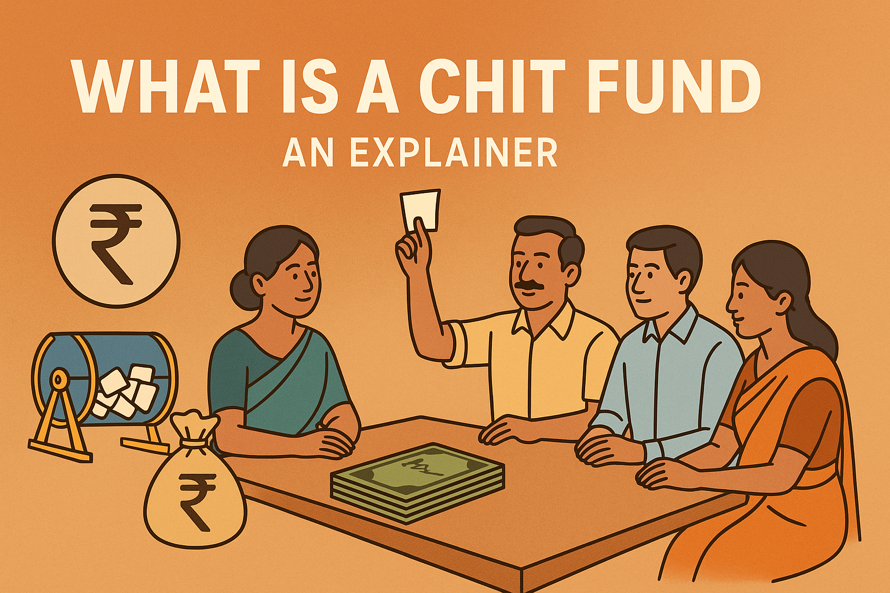
Chit Funds are one of India’s oldest and most trusted financial traditions. They combine the best of savings, borrowing, and community finance in a straightforward system. While banks and digital apps came later, chit funds existed long before, helping families, small traders, and farmers save and borrow within their local circles.
Definition and Meaning
Put simply, a chit fund is a collective savings scheme where a group of people pool money periodically and take turns receiving the total fund. The amount received by each member depends on the bid or draw for that month.
Historical Background of Chit Funds in India
Chit funds have deep roots in India’s financial history, particularly in the southern states. The concept dates back centuries, when formal banks didn’t exist.
In the 1800s, chit funds started taking shape in Kerala, Tamil Nadu, and Andhra Pradesh. Later, registered companies like Margadarsi, Shriram Chits, and Kapil Chits formalized the model.
How Chit Funds Work
Chit funds might look complex on paper, but they’re actually simple once you see the logic. Every chit fund runs on contributions, collections, and distributions.
Formation of a Chit Group
A chit group forms when people agree to contribute a fixed amount regularly for a set number of months. Suppose 25 members each contribute ₹10,000 monthly. That makes a total pot of ₹2,50,000 every month.
The scheme lasts 25 months, so each member contributes ₹2.5 lakh in total and receives ₹2.5 lakh once, but when they receive it, it can change their gain or cost depending on the bid.
Bidding or Lottery Process
This is the heart of a chit fund.
Every month, members meet for a bidding session. If it’s a bidding chit, participants offer discounts on how much they’ll take from the pot. For instance:
- Total chit value: ₹2,50,000
- One member agrees to take ₹2,10,000
- The remaining ₹40,000 is the dividend, shared equally among all members
Each person then gets ₹1,600 (₹40,000 ÷ 25).
If it’s a lottery chit, the winner is chosen randomly
Role of the Chit Fund Company
A chit fund company or foreman manages the group. They collect money, conduct the auction, handle records, and distribute dividends.
In registered setups, companies charge a small commission (usually 5%) for managing the fund. Their primary responsibility is ensuring transparency, maintaining proper accounts, and protecting members’ interests.
Types of Chit Funds
There isn’t just one kind of chit fund. Depending on who runs it and how it’s managed, chit funds come in different types.
Registered Chit Funds
Registered chit funds operate under the Chit Funds Act, 1982, and state regulations. They follow strict rules around registration, fund security, and reporting.
Members receive official receipts and records of every transaction. These funds are audited, reducing the chance of fraud or mismanagement. Big companies like Margadarsi and Kapil Chits are prime examples of registered chit funds in India.
Unregistered or Informal Chit Funds
Unregistered chit funds are community-based or office-based circles that depend purely on mutual trust. They’re popular among families, small traders, or neighborhood groups.
While convenient, they carry higher risks. Without regulation, there’s no legal recourse if the organizer mishandles funds or disappears.
Online and Digital Chit Funds
Modern fintech has brought chit funds to smartphones. Digital chit fund platforms offer paperless participation, verified KYC, automated reminders, and transparent ledgers.
Members can track bids, payments, and dividends through mobile apps. For instance, an online chit might have a ₹1 lakh pot with ₹5,000 monthly contributions.
Regulatory Framework
Regulation keeps chit funds legitimate and safe for members. India has a dedicated legal structure governing their operation.
The Chit Funds Act, 1982
This Act provides the foundation for all legal chit fund operations. It defines what a chit is, who can organize it, and how the money flow must be recorded.
Key highlights include:
- Every chit must be registered with the Registrar of Chits
- Organizers must deposit a security amount before starting the chit
- Regular reporting to the registrar is mandatory
- Violations can lead to penalties and cancellation of registration
Role of RBI and State Governments
The Reserve Bank of India (RBI) doesn’t directly regulate chit funds but collaborates with state authorities. Each state appoints a Registrar of Chits to handle registration, inspections, and dispute resolution.
Legal Requirements for Organizers
Organizers must:
- Register every chit before launch
- Deposit security equivalent to the chit value in a bank
- Maintain a dedicated account for each chit
- Issue receipts and maintain ledgers
Benefits of Chit Funds
Despite newer financial tools, chit funds remain relevant for a simple reason: they balance savings and borrowing in a single system.
Dual Benefit of Saving and Borrowing
A chit fund acts as a loan and savings plan combined. Early winners treat it as a loan, while late winners enjoy it as savings.
Example: You join a ₹1 lakh chit paying ₹5,000 monthly for 20 months. If you win in month three with a ₹15,000 bid discount, you get ₹85,000 immediately. If you win toward the end, you receive nearly the full amount after months of disciplined saving.
Flexibility in Fund Access
Unlike banks that need documents, credit checks, or collateral, chit funds rely on mutual trust. Members can access funds quickly in emergencies, perfect for small traders or families managing fluctuating incomes.
Useful for Small and Medium Income Groups
Chit funds support individuals who might lack formal loan eligibility. A shopkeeper, tailor, or private employee earning ₹25,000–₹40,000 can comfortably join a ₹2,000–₹5,000 monthly chit.
Risks and Drawbacks
Chit funds offer opportunities, but they come with responsibilities. Mismanagement and poor oversight can create problems.
Risk of Default by Members
If a participant fails to pay their share, the entire group feels the impact. Defaults delay auctions and strain relationships. Registered chit funds tackle this with penalties and replacements, but informal ones rely on goodwill alone.
Mismanagement or Fraud in Unregulated Schemes
Unregistered chit funds often operate without records. Some vanish after collecting several months’ contributions. High-profile scams like Saradha and Rose Valley highlight why regulation matters.
Lack of Transparency
In informal chits, transparency depends on the organizer’s honesty. Without clear accounting, participants rarely know how much commission is deducted or how bids are decided.
Chit Funds vs. Other Financial Instruments
Knowing how chit funds differ from common savings options helps you make smarter financial choices.
Chit Funds vs. Recurring Deposits
| Feature | Chit Fund | Recurring Deposit |
|---|---|---|
| Nature | Savings + Borrowing | Pure Savings |
| Returns | Variable | Fixed |
| Risk | Medium to High | Low |
| Regulation | Chit Funds Act, 1982 | RBI Supervision |
| Liquidity | Based on bid or draw | Locked till maturity |
Chit Funds vs. Mutual Funds
Mutual funds invest in markets, while chit funds depend on group participation. Mutual funds carry market risk; chit funds depend on human reliability.
While mutual funds may outperform in returns, chit funds win in simplicity and accessibility, especially for small savers.
Chit Funds vs. Loans
Loans are one-way; you borrow and repay with interest. Chit funds rotate this system; each member becomes both borrower and lender at different points.
Who Should Invest in Chit Funds?
Chit funds work best for those seeking discipline, liquidity, and a sense of community finance.
Suitability Based on Financial Goals
If your goal is regular saving with occasional access to lump-sum funds, chit funds fit well.
Factors to Consider Before Joining
Before joining a chit fund, always:
- Check registration details with the Registrar of Chits
- Understand the organizer’s background
- Clarify penalty clauses
- Review the fund’s duration and commission rate
FAQs
Q1: Is investing in chit funds safe?
Yes, when it’s registered and managed properly. Avoid unregistered or private setups.
Q2: Are chit funds legal in India?
Yes. The Chit Funds Act, 1982, governs them, and state governments oversee their operations.
Q3: How are chit funds different from recurring deposits?
Recurring deposits guarantee fixed returns. Chit funds vary with bids and offer both savings and
borrowing benefits.
Q4: What happens if a chit fund member defaults?
Registered organizers can take legal action or bring in backup members to maintain fund flow.
Q5: How is the chit fund dividend calculated?
It’s the discount from the winning bid, distributed equally among all members after deducting commission.
Q6: Are chit fund earnings taxable in India?
Yes. Dividends are taxed as “income from other sources” under your slab.
Q7: Can I join an online chit fund?
Yes, several fintech firms offer registered digital chit funds with verified KYC and transparent operations.
Q8: How do I verify if a chit fund is registered?
Check the registration certificate or verify the registration number with your state’s Registrar of Chits.







